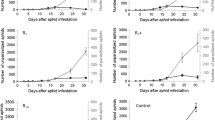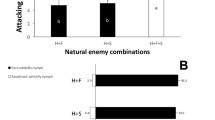Abstract
A deterministic model was developed to simulate population growth of the agromyzid flyLiriomyza bryoniae and the parasitoidDiglyphus isaea. The model has two driving variables, ambient temperature and leaf nitrogen content of the tomato plant. Results of a glasshouse experiment were used to validate the model. The timing of successive generations of leafminers was simulated accurately over four generations. Population growth of leafminers was correctly simulated during the first two generations, but overestimated in the third generation. Mortality of leafminers due to parasitism was overestimated in the first generation after introduction of parasitoids: 73% instead of the observed 30%. A nearly 100% mortality of leafminers was correctly simulated in the second generation after introduction of parasitoids. Sensitivity analysis was performed for three types of variables: (1) driving variables, temperature and leaf nitrogen content; (2) parasitoid traits, searching efficiency and allocation of attacks to host feeding and oviposition, and (3) introduction strategies for biological control, timing, number of releases and number of parasitoids per release. Population growth was sensitive to temperature, leaf nitrogen content, searching efficiency of parasitoids and numbers of parasitoids released.
Similar content being viewed by others
References
Charnov, E.L., Los-Den Hartog, R.L., Jones W.T. & Van den Assem, J., 1981. Sex-ratio evolution in a variable environment. Nature 289: 27–33.
Clark, A.G., 1987. The quantitative genetics of evolutionary constraints. In: V. Loeschke (Ed.), Genetic constraints on adaptive evolution. Springer-Verlag, Berlin: 188pp.
De Wit, C.T. & Goudriaan, J., 1978. Simulation of ecological processes. Simulation Monographs, Pudoc, Wageningen: 175 pp.
Goudriaan, J. & Van Roermund, H.J.W., 1989. Modelling of ageing, development, delays and dispersion. In: Rabbinge, R., Ward, S.A. & Van Laar, H.H., (Eds), Simulation and systems management in crop protection. Pudoc, Wageningen: 47–79.
Hassell, M.P., 1971. Mutual interference between searching insect parasites. Journal of Animal Ecology 40: 473–486.
Hassell, M.P., Lawton, J.H. & Beddington, J.R., 1976. The components of arthropod predation I. The prey death-rate. Journal of Animal Ecology 45: 135–164.
Heinz, K.M. & Parrella, M.P., 1990. The influence of host size on sex ratios in the parasitoidDiglyphus begini (Hymenoptera: Eulophidae). Ecological Entomology 15: 391–399.
Heinz, K.M., Nunney, L. & Parrella, M.P., 1990. Predictability of biological control of the leafminerLiriomyza trifolii, infesting greenhouse cut chrysanthemums. SROP/WPRS Bulletin XIII/5: 76–82.
Holling, C.S., 1959. The components of predation as revealed by a study of small-mammal predation of the European pine sawfly. Canadian Entomologist 91: 293–320.
Minkenberg, O.P.J.M. & Van Lenteren, J.C., 1986. The leafminersLiriomyza bryoniae andLiriomyza trifolii (Diptera: Agromyzidae), their parasites and host plants: a review. Agricultural University Wageningen Papers 86-2: 1–50.
Minkenberg, O.P.J.M., 1989. Temperature effects on the life history of the eulophid waspDiglyphus isaea, an ectoparasitoid of leafminers (Liriomyza spp.) on tomato. Annals of Aplied Biology 115: 381–397.
Minkenberg, O.P.J.M. & Helderman, C.A.J., 1990. Effect of temperature on the life history ofLiriomyza bryoniae (Diptera: Agromizidae) on tomato. Journal of Economic Entomology 83: 117–125.
Minkenberg, O.P.J.M. & Ottenheim, J.J.G.W., 1990. Effect of leaf nitrogen content of tomato plants on preference and performance of a leafmining fly. Oecologia 83: 291–298.
Rabbinge, R., 1976. Biological control of fruit-tree red spider mite. Simulation Monographs. Pudoc, Wageningen: 228 pp.
Rabbinge, R., Ward, S.A. & Van Laar, H.H., 1989. Simulation and systems management in crop protection. Pudoc, Wageningen: 420 pp.
Reeve, J.D., 1987. Foraging behavior ofAphytis melinus: Effects of patch density and host size. Ecology 68: 530–538.
Spencer, K.A. 1973. Agromyzidae (Diptera) of economic importance. Series Entomologica, 9. W. Junk, The Hague: 418 pp.
Van Lenteren, J.C., 1986. Parasitoids in the greenhouse: successes with seasonal inoculative release systems. In: Waage, J.K. & Greathead, D. (Eds), Insect parasitoids. Academic Press, Londen: 389 pp.
Westerman, P.R. & Minkenberg, O.P.J.M. 1986. Evaluation of the effectiveness of the parasitic waspsDiglyphus isaea andChrysocharis parksi in experimental greenhouses for the biological control of the leafminerLiriomyza bryoniae, on tomatoes. Meded. Fac. Landbouww. Rijksuniv. Gent 51: 999–1008.
Author information
Authors and Affiliations
Rights and permissions
About this article
Cite this article
Boot, W.J., Minkenberg, O.P.J.M., Rabbinge, R. et al. Biological control of the leafminer Liriomyza bryoniae by seasonal inoculative releases of Diglyphus isaea: simulation of a parasitoid-host system. Netherlands Journal of Plant Pathology 98, 203–212 (1992). https://doi.org/10.1007/BF01974383
Accepted:
Issue Date:
DOI: https://doi.org/10.1007/BF01974383




